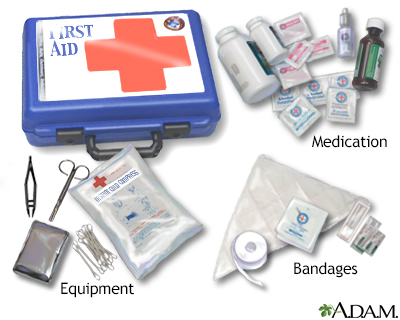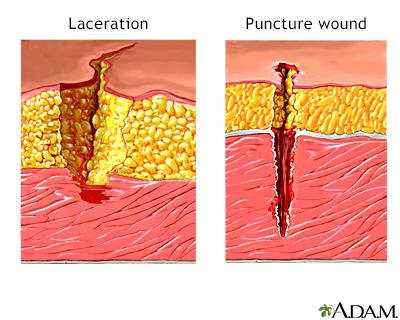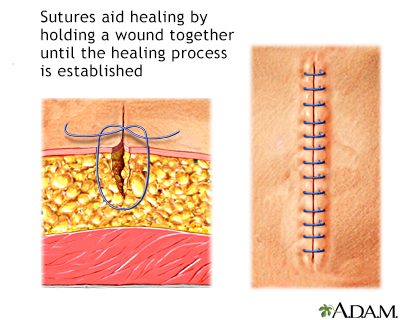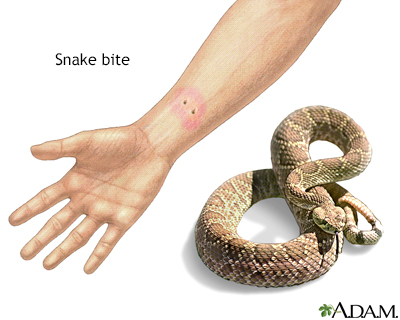Cuts and puncture wounds
Wound - cut or puncture; Open wound; Laceration; Puncture wound
A cut is a break or opening in the skin. It is also called a laceration. A cut may be deep, smooth, or jagged. It may be near the surface of the skin, or deeper. A deep cut can affect tendons, muscles, ligaments, nerves, blood vessels, or bone.
A puncture is a wound made by a pointed object such as a nail, knife, or sharp tooth. Puncture wounds often appear to be on the surface, but may extend into the deeper tissue layers.
Images




Presentation


Symptoms
Symptoms include:
- Bleeding
- Problems with function (movement) or feeling (numbness, tingling) below the wound site
- Pain
Infection may occur with some cuts and puncture wounds. The following are more likely to become infected:
- Bites
- Punctures
- Crush injuries
- Dirty wounds
- Wounds on the feet
- Wounds that are not promptly treated
First Aid
If the wound is bleeding severely, call 911 or the local emergency number.
Minor cuts and puncture wounds can be treated at home. Prompt first aid can help prevent infection and thereby speed healing and reduce the amount of scarring.
Take the following steps:
FOR MINOR CUTS
- Wash your hands with soap or antibacterial cleanser to prevent infection.
- Then, wash the cut thoroughly with mild soap and water.
- Use direct pressure to stop the bleeding.
- Apply antibacterial ointment and a clean bandage that will not stick to the wound.
FOR MINOR PUNCTURES
- Wash your hands with soap or antibacterial cleanser to prevent infection.
- Rinse the puncture for 5 minutes under running water. Then wash with soap.
- Look (but do not poke around) for objects inside the wound. If found, don't remove them. Go to your emergency or urgent care center.
- If you can't see anything inside the wound, but a piece of the object that caused the injury is missing, also seek medical attention.
- Apply antibacterial ointment and a clean bandage that will not stick to the wound.
Do Not
- Do not assume that a minor wound is clean because you can't see dirt or debris inside. Always wash it.
- Do not breathe on an open wound.
- Do not try to clean a major wound, especially after the bleeding is under control.
- Do not remove a long or deeply stuck object. Seek medical attention.
- Do not push or pick debris from a wound. Seek medical attention.
- Do not push body parts back in. Cover them with clean material until medical help arrives.
When to Contact a Medical Professional
Call 911 or the local emergency number if:
- The bleeding is severe or cannot be stopped (for example, after 10 minutes of pressure).
- The person cannot feel the injured area, or it doesn't work right.
- The person is otherwise seriously injured.
Contact your health care provider right away if:
- The wound is large or deep, even if the bleeding is not severe.
- The wound is more than a quarter inch (0.64 centimeter) deep, on the face, or reaching the bone. Stitches may be needed.
- The person has been bitten by a human or animal.
- A cut or puncture is caused by a fishhook or rusty object.
- You step on a nail or other similar object.
- An object or debris is stuck. Do not remove it yourself.
- The wound shows signs of infection such as warmth and redness in the area, a painful or throbbing sensation, fever, swelling, a red streak extending from the wound, or pus-like drainage.
- You have not had a tetanus shot within the last 10 years.
Prevention
Keep knives, scissors, sharp objects, firearms, and fragile items out of the reach of children. When children are old enough, teach them to how to use knives, scissors, and other tools safely.
Make sure you and your child are up to date on vaccinations. A tetanus vaccine is generally recommended every 10 years.
References
Ball JW, Dains JE, Flynn JA, Solomon BS, Stewart RW, et al. Skin, hair, and nails. In: Ball JW, Dains JE, Flynn JA, Solomon BS, Stewart RW, eds. Seidel's Guide to Physical Examination. 10th ed. St Louis, MO: Elsevier; 2023:chap 9.
Lammers RL, Aldy KN. Principles of wound management. In: Roberts JR, Custalow CB, Thomsen TW, eds. Roberts and Hedges' Clinical Procedures in Emergency Medicine and Acute Care. 7th ed. Philadelphia, PA: Elsevier; 2019:chap 34.
Simon BC, Hern HG. Wound management principles. In: Walls RM, ed. Rosen's Emergency Medicine: Concepts and Clinical Practice. 10th ed. Philadelphia, PA: Elsevier; 2023:chap 52.
BACK TO TOPReview Date: 11/2/2023
Reviewed By: Jesse Borke, MD, CPE, FAAEM, FACEP, Attending Physician at Kaiser Permanente, Orange County, CA. Also reviewed by David C. Dugdale, MD, Medical Director, Brenda Conaway, Editorial Director, and the A.D.A.M. Editorial team.

Health Content Provider
06/01/2025
|
A.D.A.M., Inc. is accredited by URAC, for Health Content Provider (www.urac.org). URAC's accreditation program is an independent audit to verify that A.D.A.M. follows rigorous standards of quality and accountability. A.D.A.M. is among the first to achieve this important distinction for online health information and services. Learn more about A.D.A.M.'s editorial policy, editorial process and privacy policy. A.D.A.M. is also a founding member of Hi-Ethics. This site complied with the HONcode standard for trustworthy health information from 1995 to 2022, after which HON (Health On the Net, a not-for-profit organization that promoted transparent and reliable health information online) was discontinued. |
The information provided herein should not be used during any medical emergency or for the diagnosis or treatment of any medical condition. A licensed medical professional should be consulted for diagnosis and treatment of any and all medical conditions. Links to other sites are provided for information only -- they do not constitute endorsements of those other sites. © 1997- 2025 A.D.A.M., a business unit of Ebix, Inc. Any duplication or distribution of the information contained herein is strictly prohibited.
